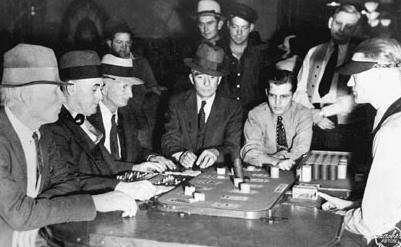The game of faro was played in France as early as the seventeenth century. The game came to North America through the colonial port of New Orleans. As Louisiana was transferred to the new nation, the game became very popular on Mississippi riverboats and on the Western frontier. The game survived late into the twentieth century in Nevada casinos. Its slow action combined with its low return for the casinos, however, caused houses to drop faro in favor of games such as the increasingly popular blackjack.

A faro game at the Old Las Vegas Club in Las Vegas.
The word faro was derived from the word pharaoh, as the winning card was seen as the “king”. The rather simple luck game is played on a layout called a faro bank. The table has pictures of cards on two sides, the ace through six on one side, the seven at the end in the center, and the eight through the king on the other side. There is also an area marked as “high” on one side. Cards are dealt from a fifty-two-card deck. Suits are not considered, only the card values. After a first card is exposed and discarded, twenty-five two-card pairs are dealt, leaving one remaining card that is not played. The pairs are dealt one card at a time. The first card is a losing card, the second one a winning card. Basically, the players bet that a certain numbered card will appear as the winning or losing card in a pair when the card is next exposed. Correct bets are paid even money. If the card comes up and the other card of the pair is the same, the house wins half of the bet. If a pair does not contain the card, the bet remains until the card comes up in a future pair. For instance, if the bet is that a six will lose, cards are dealt in pairs until a six comes up, either as a winning or losing part of the pair. If two sixes come up, the player loses half the bet. The dealer records which numbers have been played, and so the player can make subsequent bets with a knowledge about chances that a pair will be dealt with that number. The house edge starts at about 2.94 percent when the first pair is dealt and increases against players betting on subsequent pairs if the card bet upon (for example, a six) has not yet appeared. If three of the four sixes have appeared, however, the house edge is gone if the player bets the six will either be a winner or loser when it comes up the fourth time. Players betting on the high can bet that the winning or the losing card will be a higher-valued card.
There is also a variety of combination bets, many of which give the player a very bad disadvantage. The changing odds structures of the game can be calculated as play progresses, giving the game many strategies. The game attracted many systems players, and their many deliberations caused play to be slow compared to other casino games. In early times, systems were probably to no avail as games at the mining camps and on the riverboats were known to often be run by cheaters and sharps.